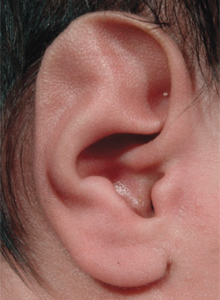Can Stahl’s Ear Be Fixed Without Surgery? Here’s What Parents Need to Know
Does your newborn have a Stahl’s Ear deformity? A Stahl’s Ear deformity is one in which the ears are pointed at the top and may occur in just one or in both ears. It is sometimes called Elfin Ear, as well as Spock Ear, as Stahl’s ear is similar to the appearance of Dr. Spock’s ears from the Star Trek TV series. It is often genetic (you may have other family members with pointed ears), and it cancause many years of unwanted attention from peers—even family members—as your baby grows up. 
Parents of children with a Stahl’s Ear deformity are often confused about the options to remold the ears into a normal appearance. Should we wait to have an otoplasty, a surgical procedure, to fix our newborn’s ears? Is there another option? Rest assured, there is another option to fix Stahl’s Ear: a non-surgical Stahl’s ear treatment called EarWell.
For purposes of comparison, however, let’s delve into the two options for a resolution to a Stahl’s Ear deformity: Surgery vs Ear Molding.
The Benefits of Surgical Treatment for Stahl’s Ear:
An otoplasty, which is the name of the surgery to remodel the ears, is an outpatient procedure performed under general anesthesia. It is done only after the child’s ears have reached near-adult size, which is approximately 5 or 6 years of age. At this age, a child is capable of understanding what is happening and to follow instructions under the guidance of a parent or guardian about postop care, such as taking any pain medication(s) that are prescribed, not touching the ears during recovery, and avoiding roughhousing, etc.
For a child that has already been teased or bullied about his appearance, an otoplasty can be a welcome escape from ears that have brought the child the challenges of being “different” from others. Thus, an otoplasty can boost the child’s self-esteem and increase social comfort.
An otoplasty is generally a permanent solution to Stahl’s Ears, and can be performed on one or both ears. If only one ear has a Stahl’s Ear deformity, the surgeon will carefully match the Stahl’s ear to the normal ear during the procedure.
The Drawbacks of Surgical Treatment for Stahl’s Ear:
Because otoplasty cannot be performed until your baby is 5 years or older, your child is open to teasing—even bullying—from others until they reach school age. The upshot of your child’s exposure to hurtful and/or negative comments at a tender age can, unfortunately, last a lifetime, even after the ears have been brought to a normal appearance.
Otoplasty is a surgical procedure that involves incisions, general anesthesia, postop dressings and an estimated 2-week recovery time with some discomfort, during which your child will wear a dressing over the ear(s), be instructed not to touch the healing ears, and submit to dressings and possibly pain medications.
As with any surgical procedure, there is always a risk, albeit small, of postop infection and/or problems with general anesthesia.
Otoplasty is an elective cosmetic surgery procedure and, as such, is not covered by health insurance, whether public or private. The cost of an otoplasty can range up to $10,000 or more, depending on your choice of surgeon.
There are Two Reasons for Otoplasty vs. Non-surgical Stahl’s Ear Treatment:
- The child is too old for EarWell treatment, which must be initiated while the child’s ear cartilage is still soft, essentially within the first 3-6 weeks after birth. After that period of time, the child’s ears will harden and it will be difficult—if not impossible—to remold the ears with EarWell.
- The Stahl’s Ear deformity is such that EarWell cannot successfully remold the ears to a normal appearance. This is extremely rare, as EarWell has been shown over several decades and tens of thousands of infants to effect a near-100% resolution of a wide range of external ear deformities, including Stahl’s Ear.
Non-Surgical Stahl’s Ear Treatment with EarWell:
As mentioned earlier, Stahl’s ear, characterized by an extra cartilage fold creating a pointed shape, typically cannot be permanently corrected without surgery if the cartilage has hardened. However, when placed on newborns within the first few weeks of life, non-surgical methods like EarWell ear molding can permanently reshape the ear(s), as the cartilage is still soft and pliable. For that reason, it is essential for parents to evaluate the options of EarWell treatment for their infant.
The Benefits of Non-Surgical Treatment for Stahl’s Ear:
EarWell is applied shortly after birth, without a need for anesthesia, without discomfort to the newborn baby, and with no involvement from the parents other than taking the baby to the EarWell provider—no need to worry about dressings, sutures, infection, pain, or any other issue involved with the surgical treatment for Stahl’s ear. Furthermore, the child’s ears are remodeled long before he or she is exposed to other children, so teasing or bullying because of a “difference” in appearance simply doesn’t exist.
Not to be underrated, the cost of EarWell treatment is almost always covered all or in part by health insurance, including public programs such as Calcaid and Medicaid, and military health coverage. In our experience over several decades, it is extremely rare that a health insurer does not cover the cost of EarWell treatment.
So, to answer the question, “Can Stahl’s Ear Be Fixed Without Surgery?”
the answer is a resounding, YES, with EarWell!
Why wait? Click the EarWell Provider Portal link to find the EarWell physician nearest you. If you have any trouble, concerns or questions, call us at 866-431-0480 or contact us via this link.






